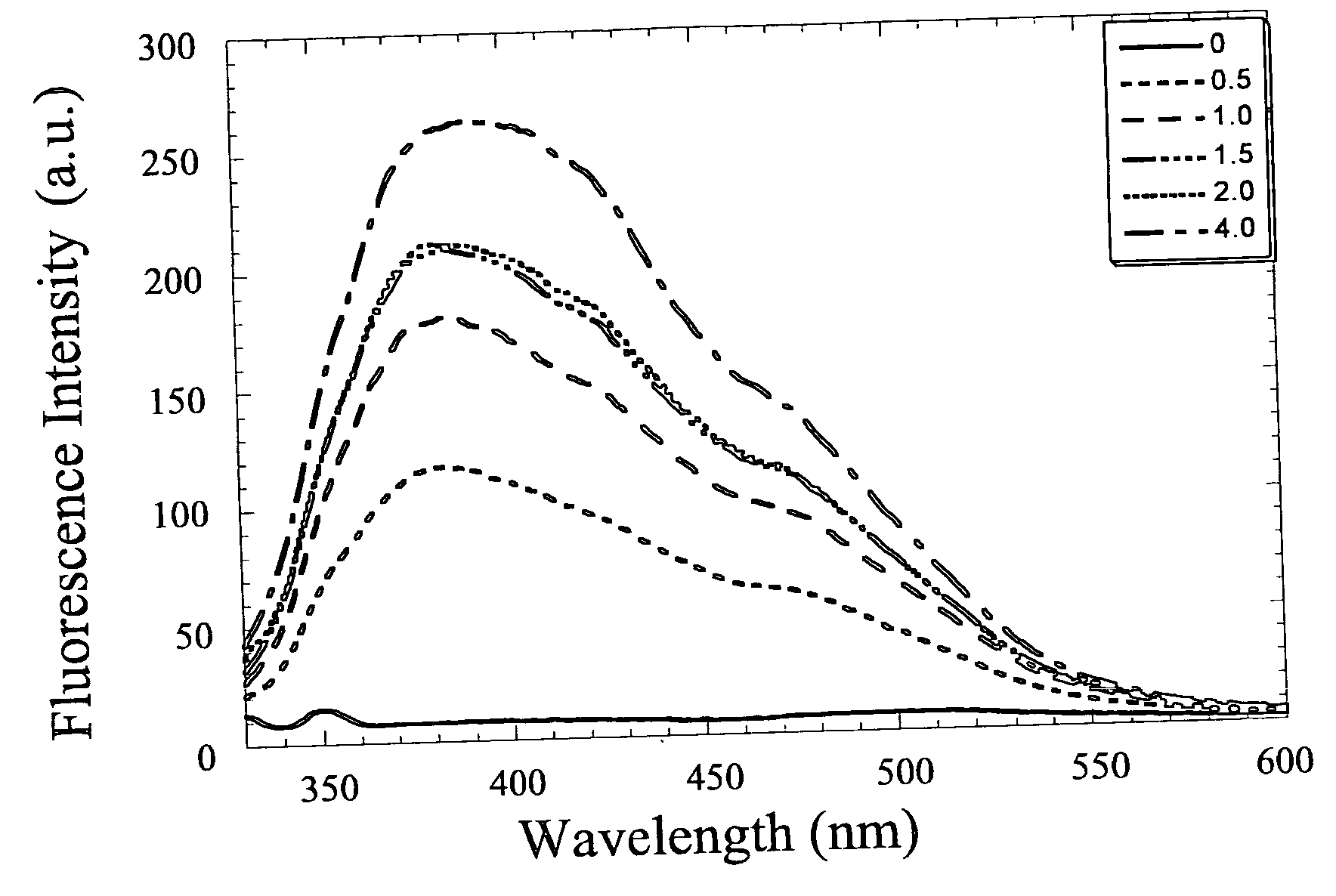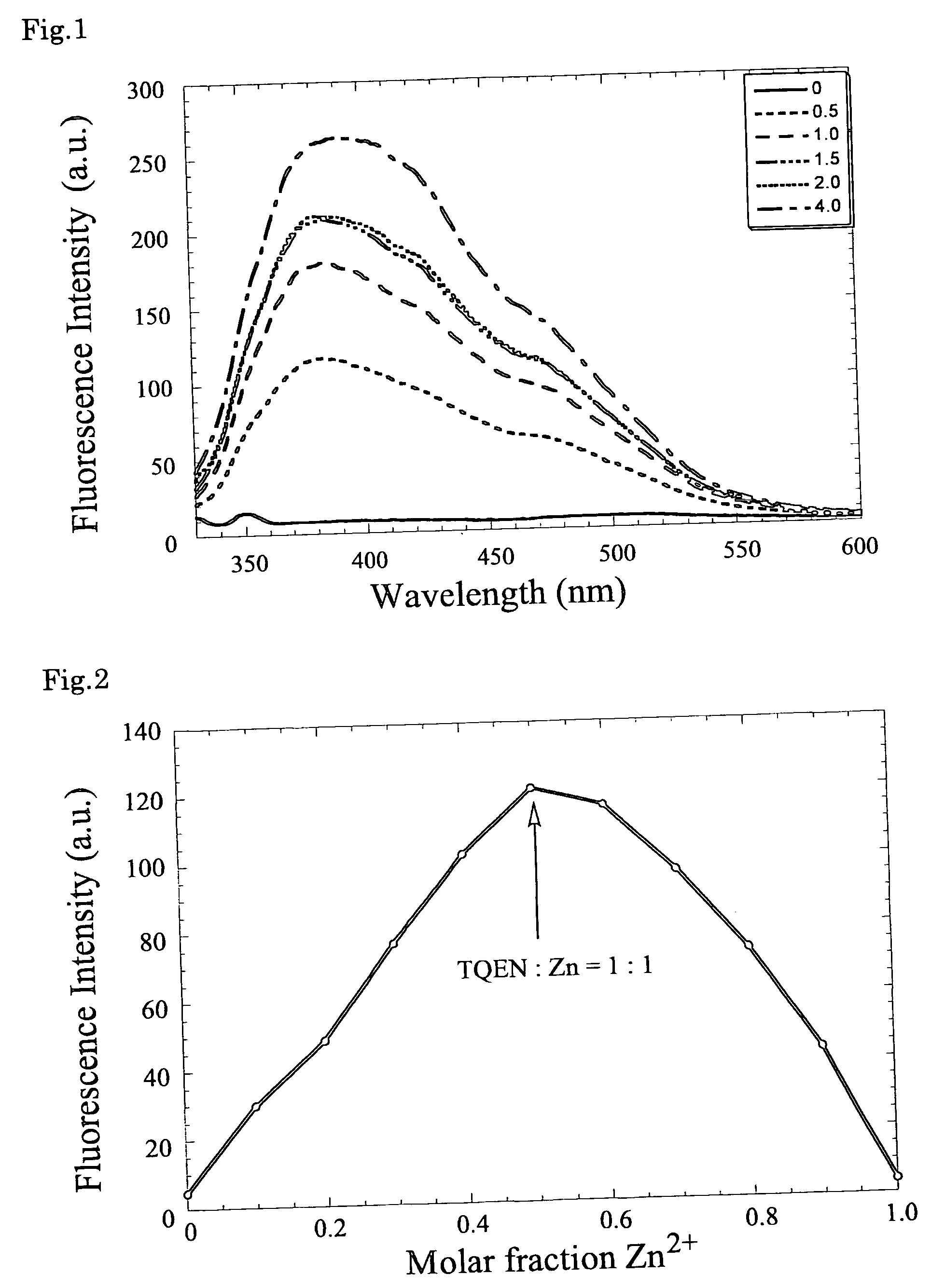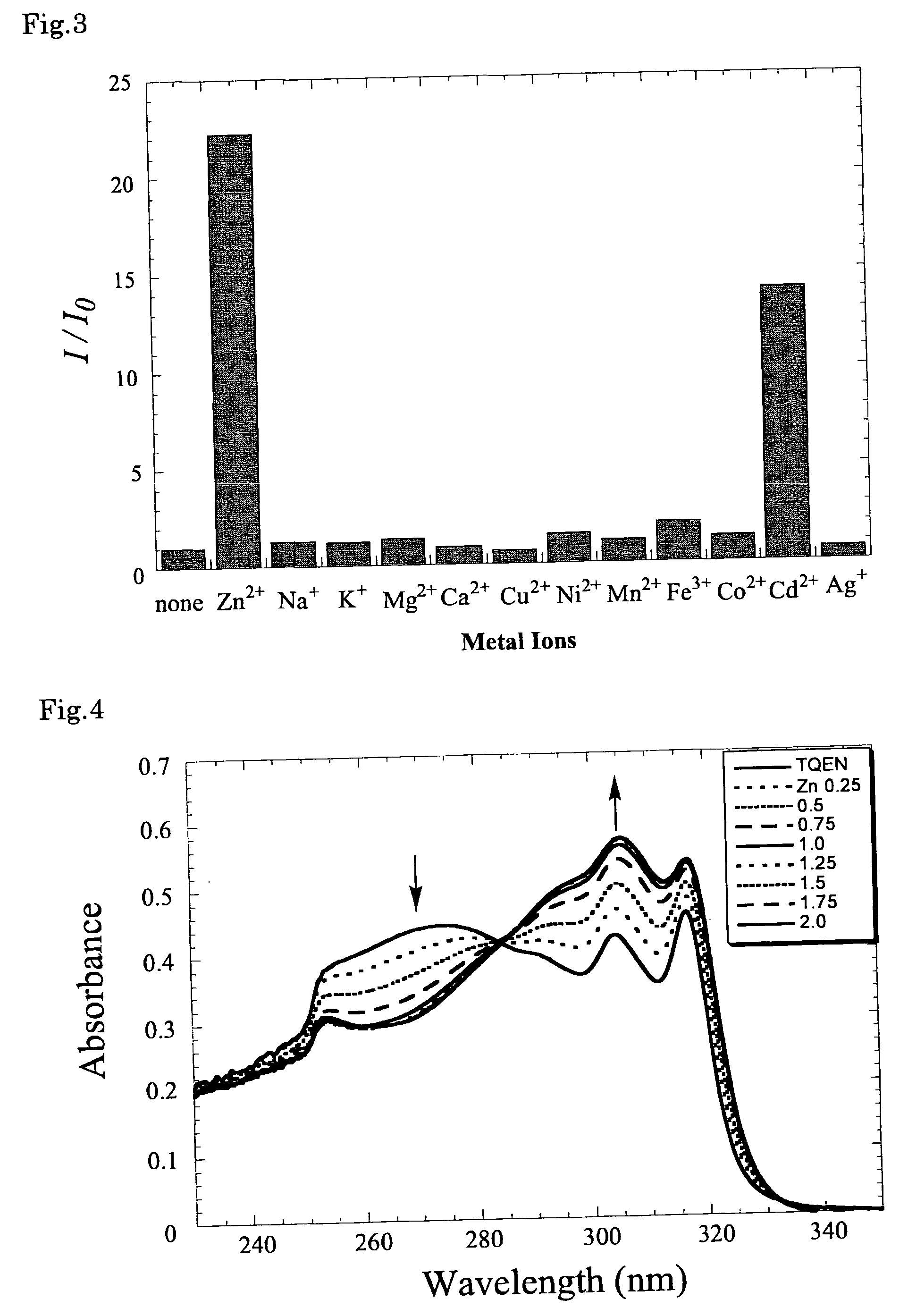Fluorescent zinc ion sensor
a technology of fluorescence zinc and ion sensors, applied in the field of fluorescence zinc ion sensors, can solve the problems of high background fluorescence level, inability to manufacture in a large scale at low cost, and difficulty in quantitative analysis, etc., and achieve the effect of superior fluorescent characteristics and low cos
- Summary
- Abstract
- Description
- Claims
- Application Information
AI Technical Summary
Benefits of technology
Problems solved by technology
Method used
Image
Examples
example 1
Synthesis of N,N,N′,N′-tetrakis(2-quinolylmethyl)ethylenediamine (TQEN)
[0031] A mixture of 2-chloromethylquinoline hydrochloride (1.07 g, 5 mmol), ethylenediamine (7.50 mg, 1.25 mmol), potassium carbonate (2.07 g, 15 mmol) and acetonitrile (10 mL) was refluxed by heating for 48 hours. The solvent was evaporated under reduced pressure, and then the residue was separated by phase separation using chloroform and water. The organic layer was dried, and the solvent was evaporated. The residue was washed with acetone to obtain the objective compound as white powder (0.70 g, 89%).
[0032] mp 196 to 198° C. 1H NMR (CDCl3) δ (ppm): 2.89 (s, 4H), 3.96 (s, 8H), 7.49-7.54 (m, 8H), 7.66-7.71 (q, 8H), 7.87 (d, 4H), 7.99 (d, 4H) 13C NMR (CDCl3) δ (ppm): 52.58, 61.56, 120.85, 125.95, 127.16, 127.34, 128.88, 129.23, 136.08, 147.40, 160.29 ESI-MS calcd. for C42H37N6 ([M+H]+): 625.3074; Found: 625.3070 Anal. calcd. for C42H36N6: C, 80.61; H, 5.96; N, 13.43, Found: C, 80.69; H, 5.92; N, 13.41
example 2
Synthesis of [Zn(TQEN)](ClO4)2
[0033] A mixture of TQEN (0.31 g, 0.50 mmol) and zinc perchlorate (0.18 g, 0.49 mmol) was stirred in acetonitrile at room temperature for 4 days. A small amount of unnecessary substances were removed by filtration, and then the solvent was evaporated under reduced pressure. The obtained residue was recrystallized from acetonitrile / ether to obtain a single crystal suitable for X-ray crystal structure analysis.
[0034]1H NMR (CD3CN) δ (ppm): 3.18 (s, 4H), 4.1 (br., 4H), 4.43 (d, 4H), 7.3 (br., 4H), 7.46 (d, 4H), 7.5-7.7 (m, 4H), 8.07 (d, 4H), 8.56 (d, 4H) 13C NMR (CD3CN) δ (ppm): 57.00, 63.18, 123.17, 126.45, 129.19, 130.45, 130.79, 132.83, 142.94, 145.72, 160.78 ESI-MS calcd. for C42H36N6ZnClO4 ([Zn(TQEN)]ClO4): 787.1773; Found: 787.1766 Anal. calcd. for C42H38N6ZnCl2O9([Zn(TQEN)](ClO4)2.H2O): C, 55.61; H, 4.22; N, 9.26, Found: C, 55.85; H, 4.18; N, 9.35
example 3
Synthesis of 6-methoxy-2-bromomethylquinoline
[0035] A mixture of 6-methoxy-2-methylquinoline (999 mg, 5.77 mmol), NBS (1.03 g, 5.77 mmol), AIBN (153 mg) and chlorobenzene (10 mL) was stirred at 120° C. for 2 hours, then added with AIBN (153 mg) again and further stirred for 4 hours with heating. The solvent was evaporated under reduced pressure, and then the residue was extracted with ether. The solvent was evaporated, and the residue was recrystallized from ethanol to obtain 6-methoxy-2-bromomethylquinoline as white powder (yield: 400 mg, 1.59 mmol, 28%).
[0036]1H NMR (CDCl3) δ (ppm): 3.94 (s, 3H), 4.70 (s, 2H), 7.08 (d, 1H), 7.39 (q, 1H), 7.53 (d, 1H), 7.97 (d, 1H), 8.07 (d, 1H) 13C NMR (CDCl3) δ (ppm): 34.70, 55.69, 105.22, 121.74, 122.94, 128.68, 130.95, 136.25, 143.87, 154.62, 158.52
PUM
| Property | Measurement | Unit |
|---|---|---|
| pH | aaaaa | aaaaa |
| twisting angle | aaaaa | aaaaa |
| absorption wavelength | aaaaa | aaaaa |
Abstract
Description
Claims
Application Information
 Login to View More
Login to View More - R&D
- Intellectual Property
- Life Sciences
- Materials
- Tech Scout
- Unparalleled Data Quality
- Higher Quality Content
- 60% Fewer Hallucinations
Browse by: Latest US Patents, China's latest patents, Technical Efficacy Thesaurus, Application Domain, Technology Topic, Popular Technical Reports.
© 2025 PatSnap. All rights reserved.Legal|Privacy policy|Modern Slavery Act Transparency Statement|Sitemap|About US| Contact US: help@patsnap.com



